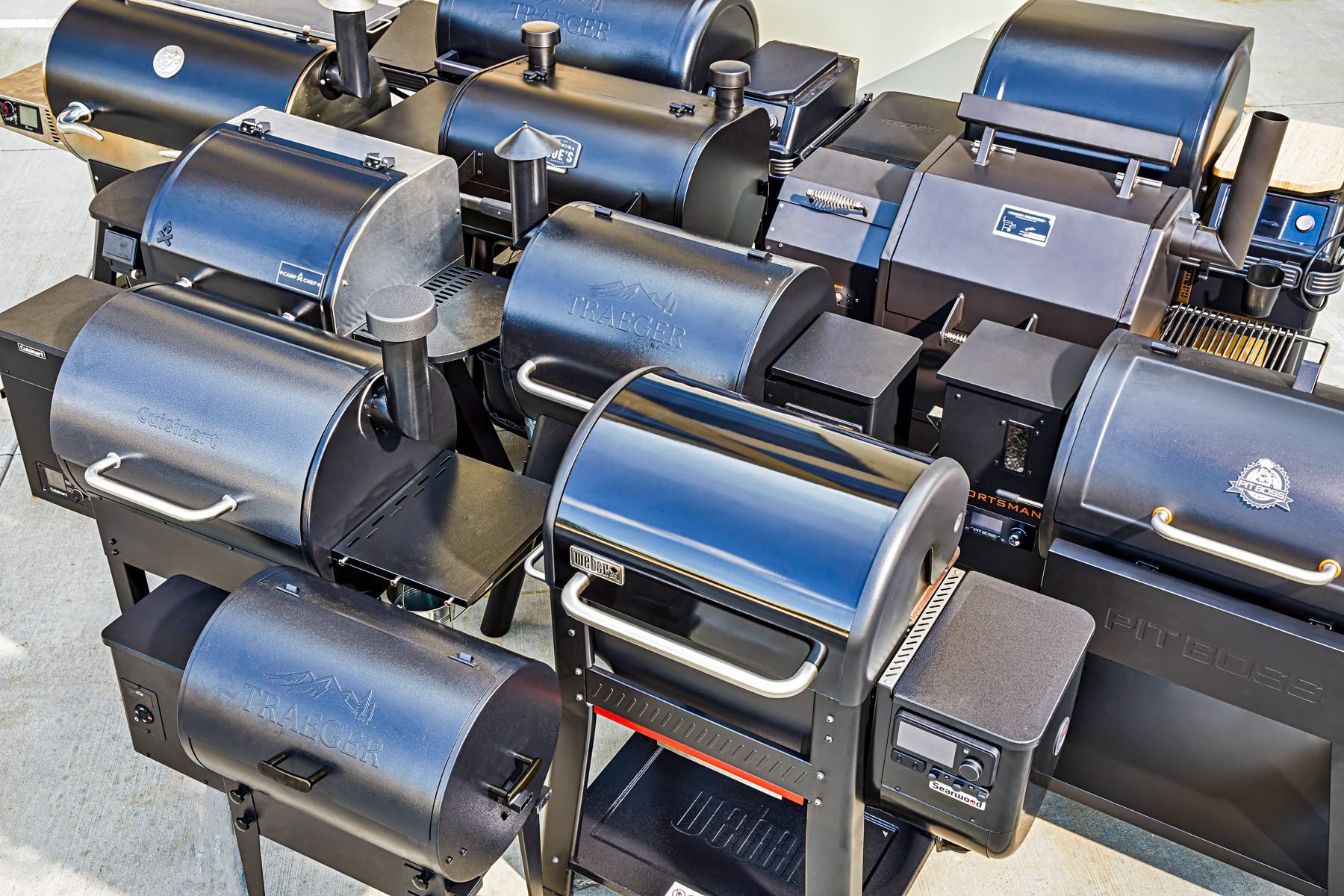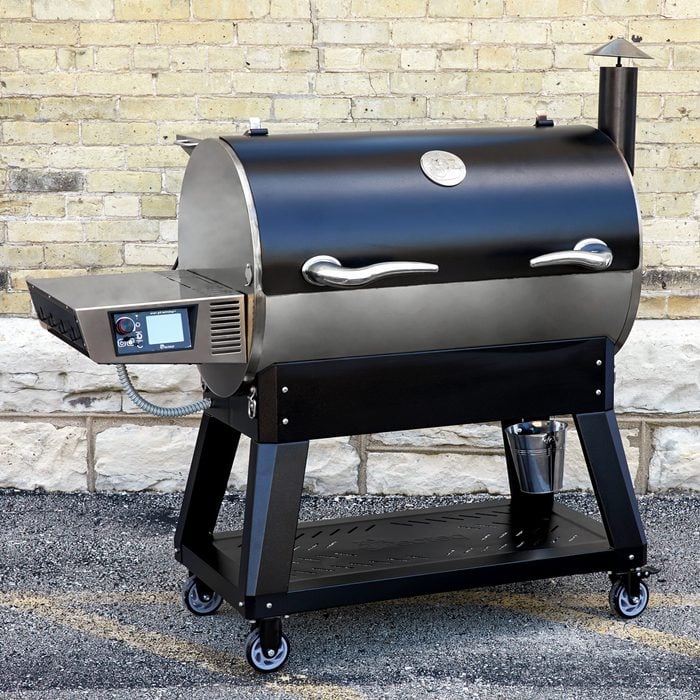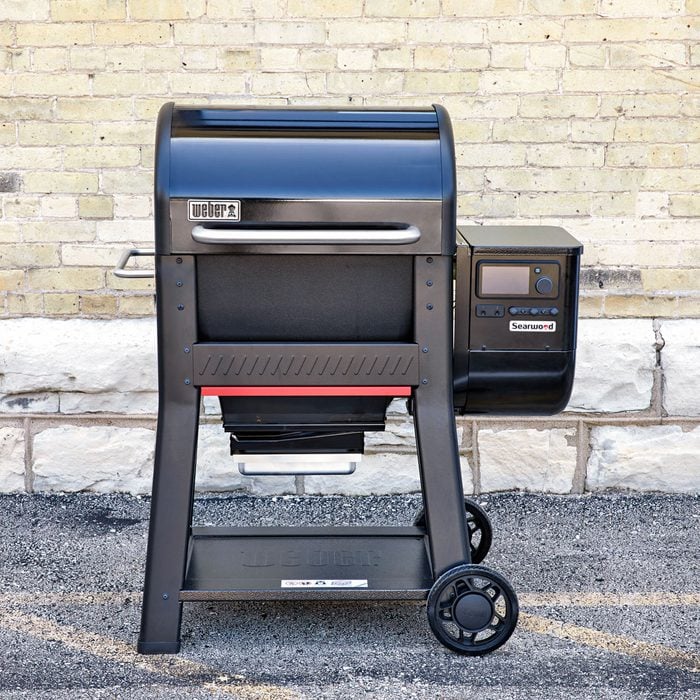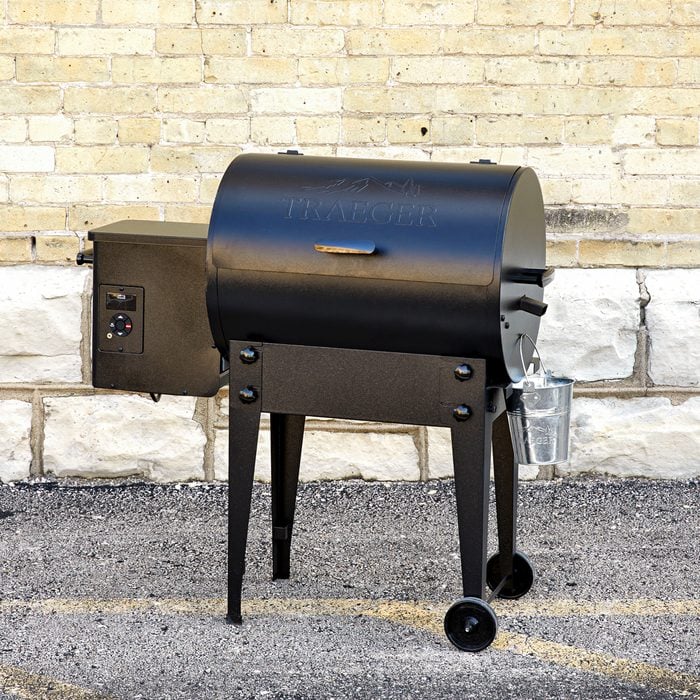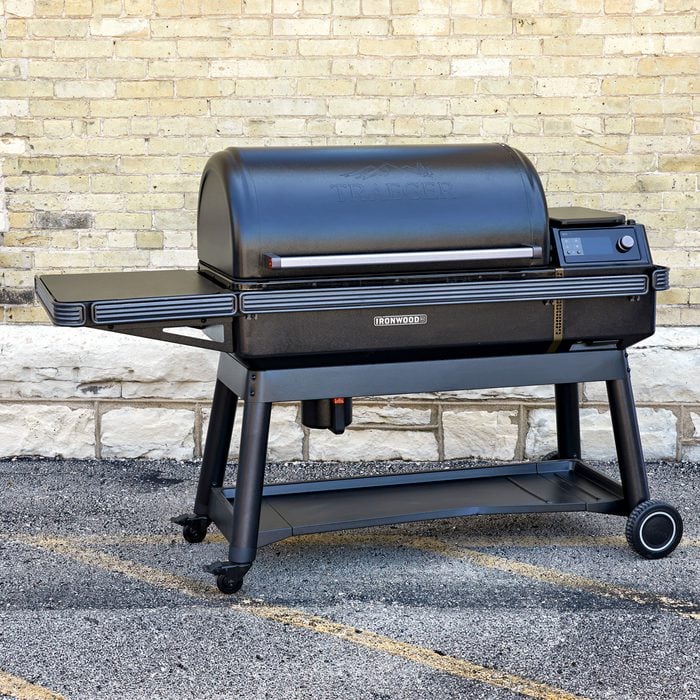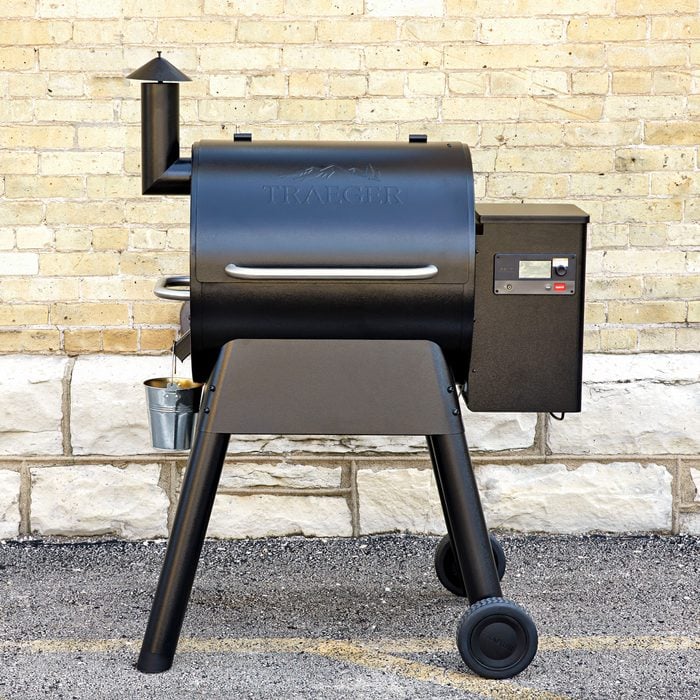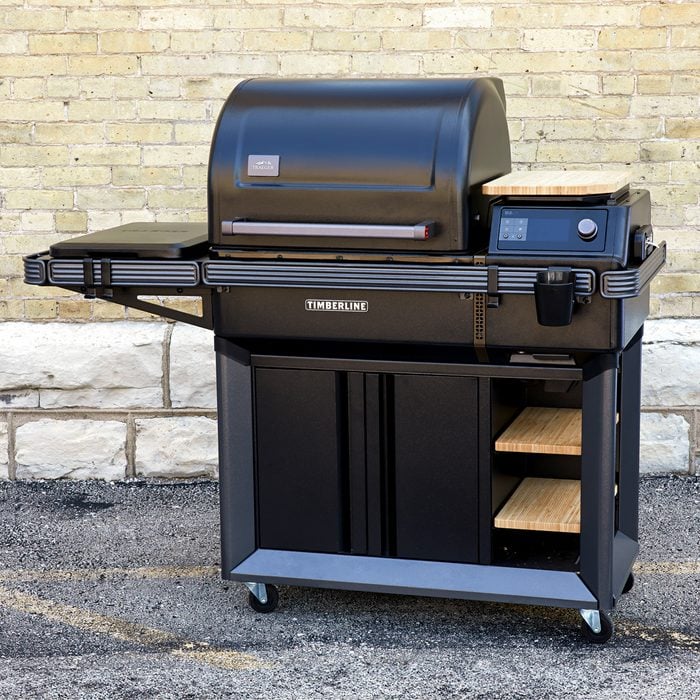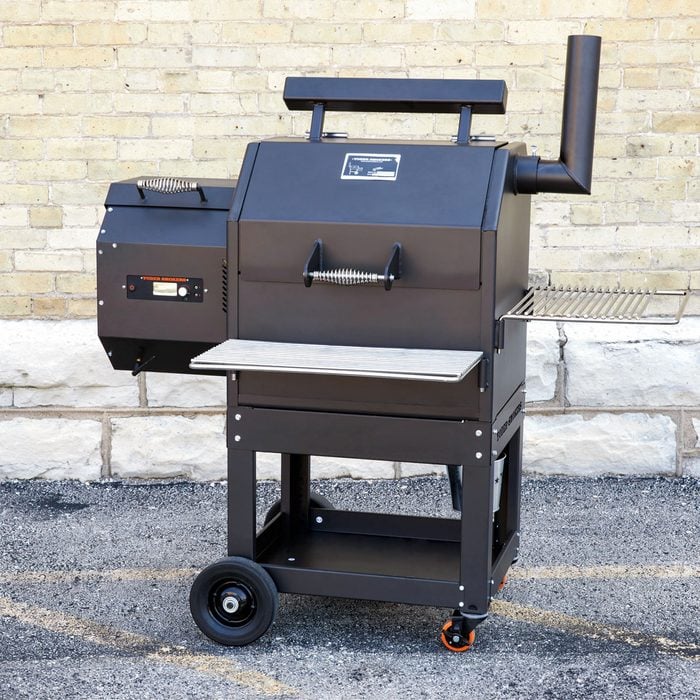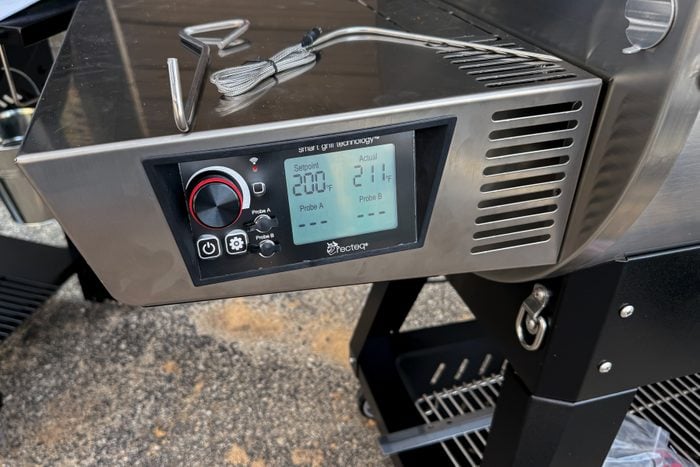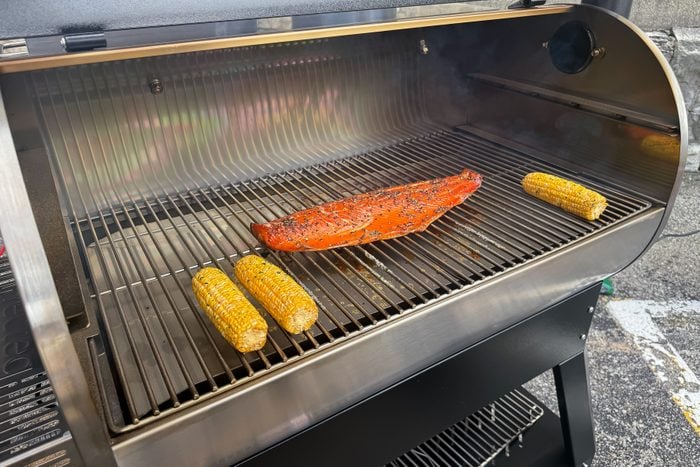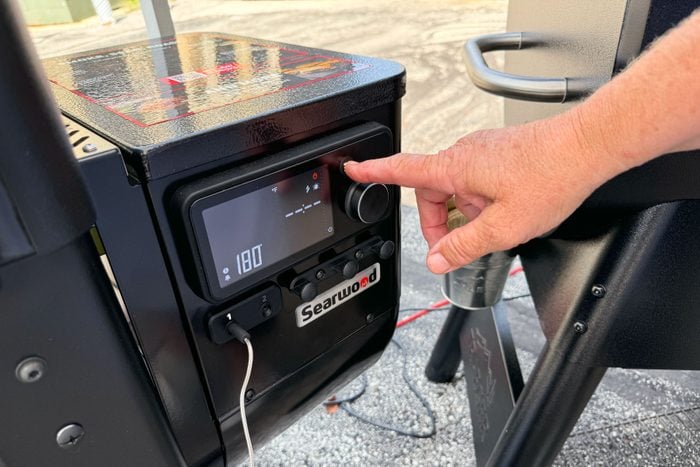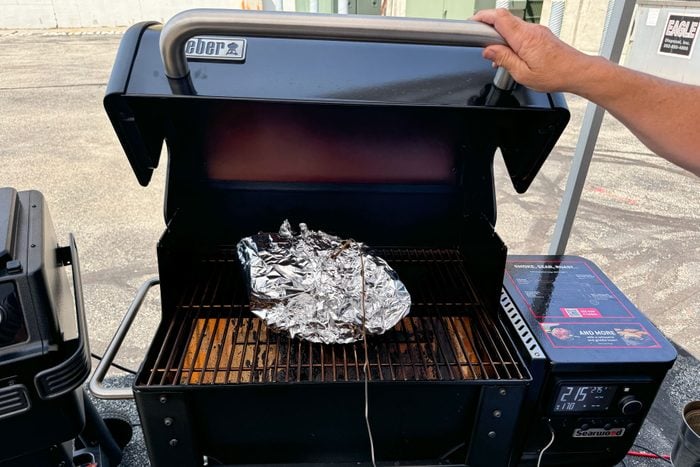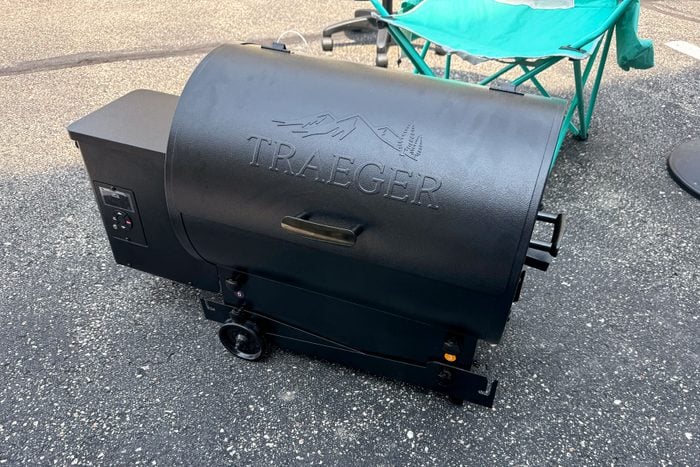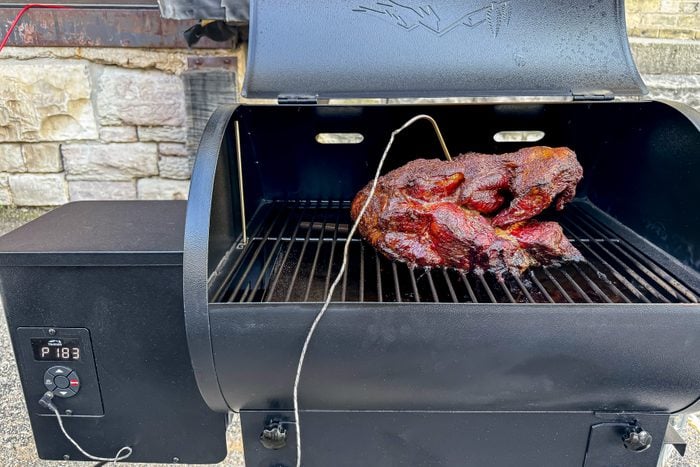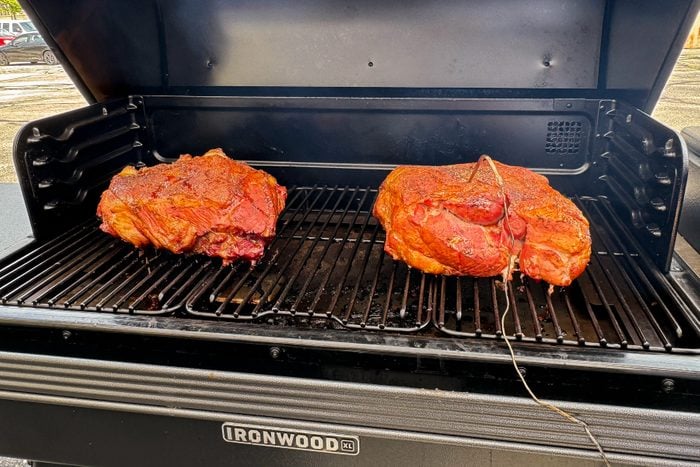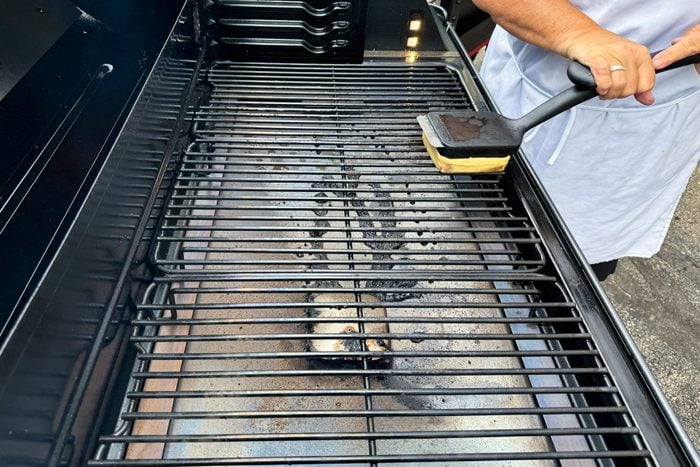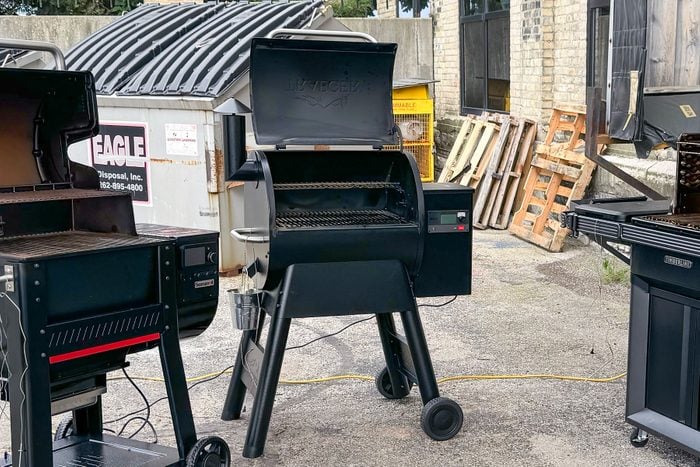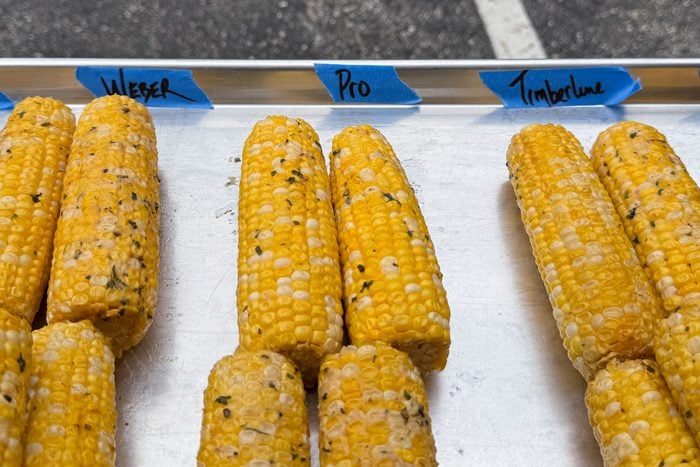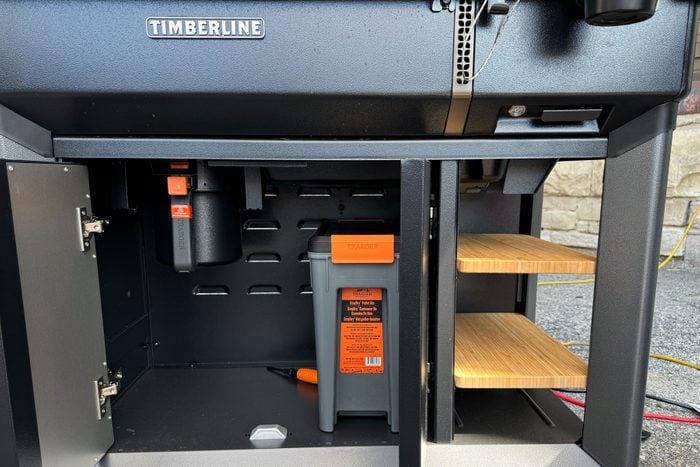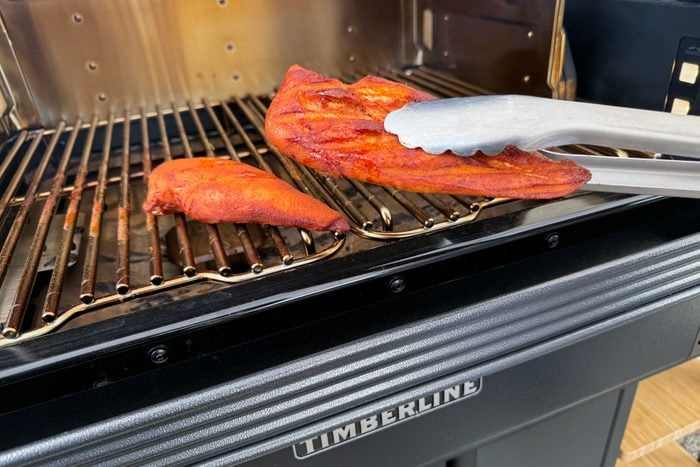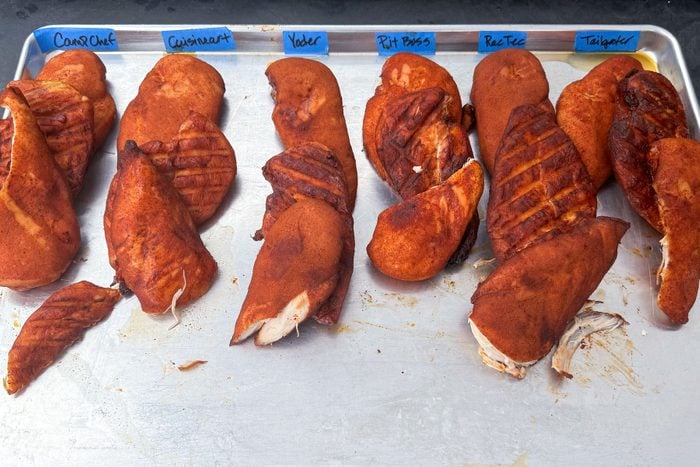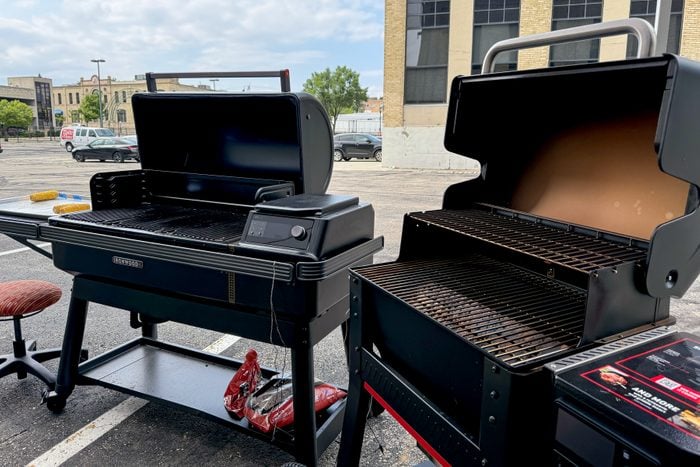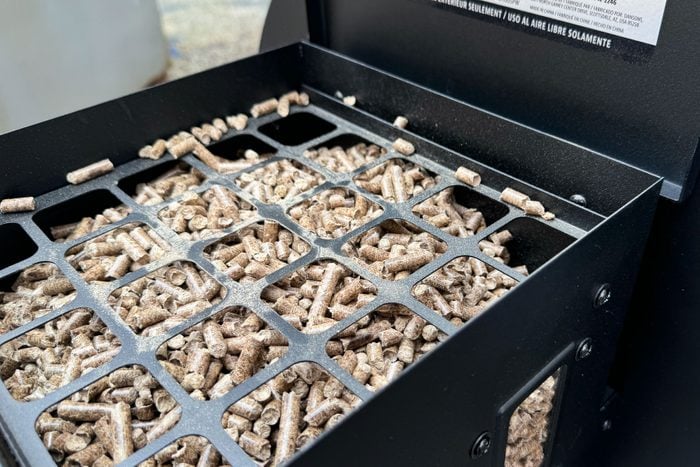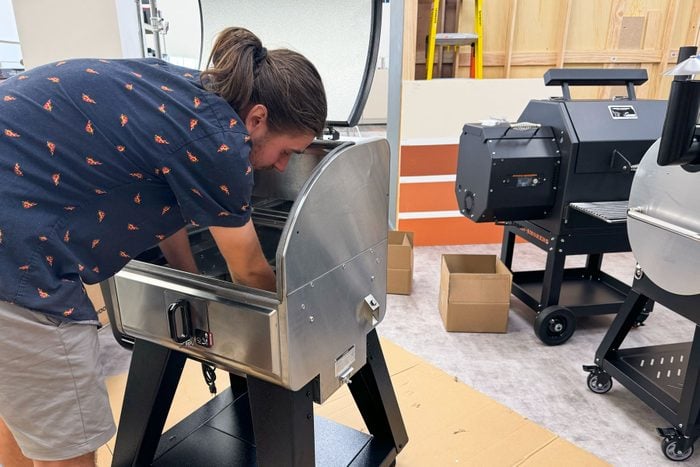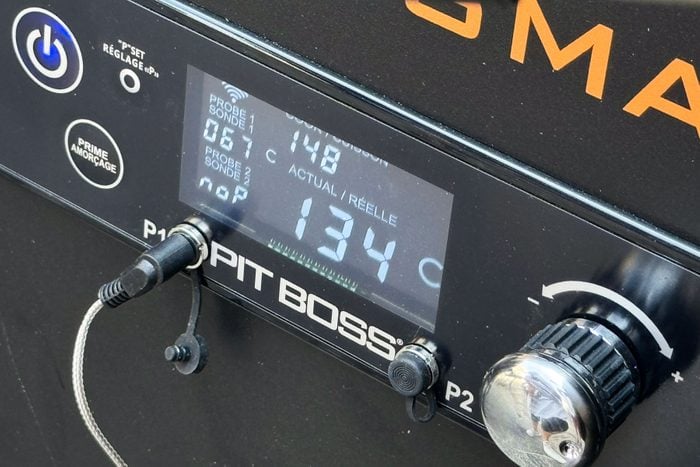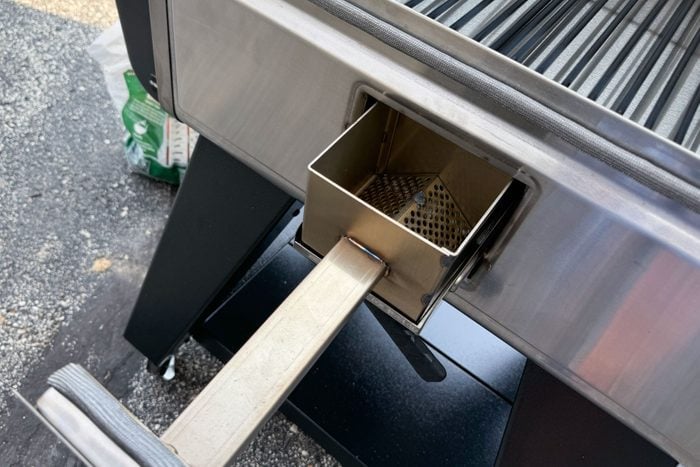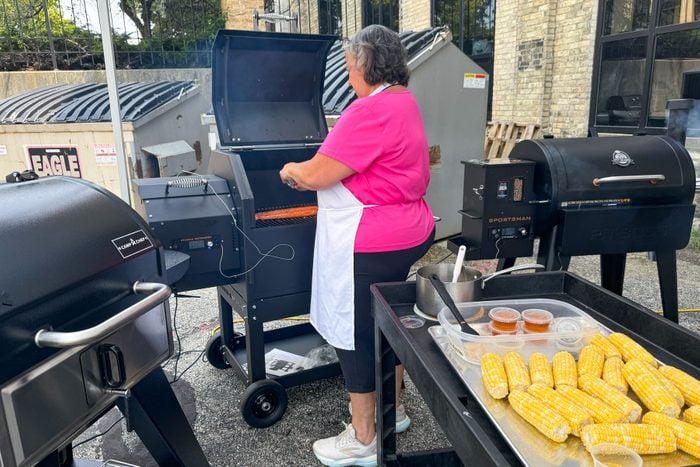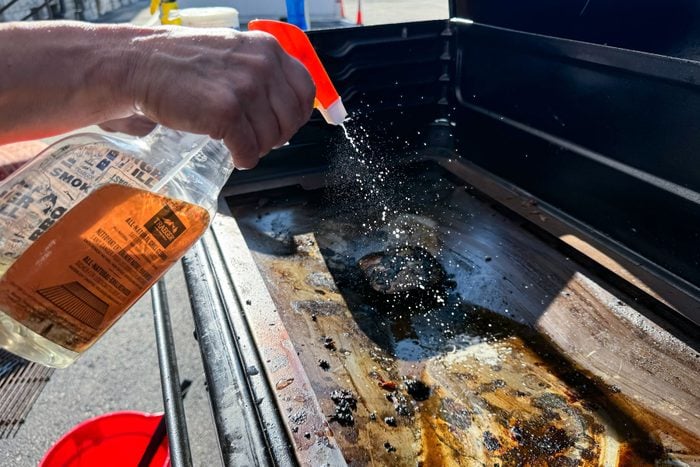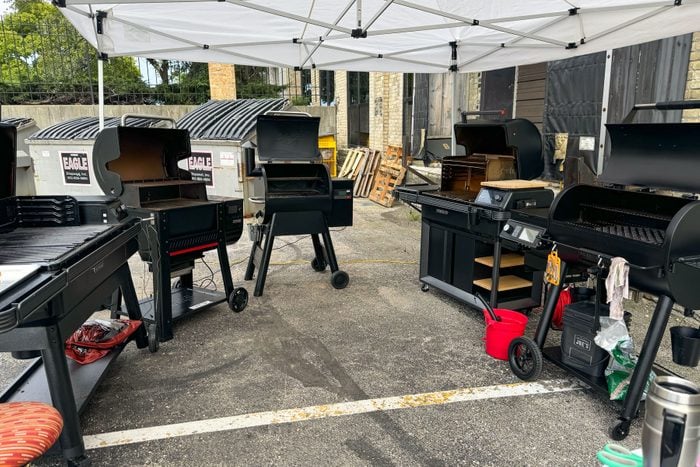Pros:
-
Easy-to-use interface
-
Large grilling area
-
Adjustable grates
-
Attractive kitchen-ready design
-
Induction burner on the side
-
Removable cutting board
Cons:
-
Not the best at searing
-
Pricey
-
Lengthy, 20-minute shut down cycle
Whether you plan on plank grilling or showing off your low and slow roasts, the Traeger Timberline is well worth the splurge for serious pit fiends. The super sleek kitchen-ready design is only the tip of the iceberg. It includes a whopping 880 square inches of grilling space and an induction burner on the side that’s compatible with magnetic cookware. Adjustable grates also allow users to customize each cook based on their needs.
“It’s a good performer with some showy extra features,” says Catherine. “The wood accents make it very appealing to look at. Sheri even discovered that the cutting board on the side table is removable (attached with a very strong magnet).” The Timberline looks and feels like a mini outdoor kitchen on wheels. Apart from the grilling features, it offers accessory hooks, courtesy lights, towel racks and a side basket accessory shelf. It even comes with a plastic cupholder that holds the chef’s favorite non-alcoholic beer.
TASTE OF HOME
The easy-to-use interface worked well when coupled with the WiFi features and app. Set the temperature and a timer, manually select the “Super Smoke” or “Keep Warm” feature or engage the shut-down button. It also lets you know what percentage of the hopper is full. There’s a grill and maintenance section that tells you how to clean and maintain your grill. There are also pages full of recipes and tutorials, along with shoppable sections where you can buy sauces and pellets or locate a Traeger dealer.
Catherine is a big fan of the touchscreen controls, finding them easy and organized. Each setting has its own sub-menu, which helps make things feel more intuitive. As you boost the temperature, the screen automatically switches from “Smoking” to “Grilling” to “Searing,” a feature we love.
“The Timberline corn would pair with any type of food without overpowering it,” says Mark Derse, our photographer. It came out slightly smoky with a light flavor. The grill produced near-perfect chicken that had lots of bark and a juicy interior, with a light mahogany top and mild, smoky flavor. Similarly, the pork chops received a little color along the edges (though not as much as we’d like), and the pork shoulder offered beautiful, complex flavors and a nice color.
TASTE OF HOME
However, with more tech comes more issues. Testers note that after 30 minutes of cooking the chops, the grill went into its 30-minute shutdown cycle. Then, they had to turn it off because it said it was too hot (500 degrees Fahrenheit). After they turned it back on, it prompted a deep-clean notification, even though the grill was thoroughly cleaned. After a restart, the grill worked as expected. We don’t think this was a big issue, but we want to make note of it—especially given the high price point.
Grate materials: Stainless steel | Weight: 238 pounds | Cooking area: 880 square inches | WiFi/Bluetooth connectivity?: Yes | Special Features: Touchscreen; two wireless probes; two wired probes; induction cooktop | Warranty: 10 years
Pros:
-
Keeps smoke inside
-
Separate searing grate
-
Locks on wheels
-
Comes with repair paint
-
Side tables
Cons:
-
Bulky and difficult to move
-
Scratches easily
-
Silicone buttons
Big cooking areas and small grills don’t typically mix, but the Yoder Smokers YS480s pellet grill proves that’s not always the case. It boasts a behemoth 800 square inches of grilling space while still only taking up around 53 inches lengthwise. This pick for the best pellet grill for compact spaces maximizes surface area by utilizing one lower row with three cooking grates and a second-level slide-out cooking shelf.
“The instructions are not super clear for this smoker,” notes Ben Landwehr, TMB studio assistant of the smoker assembly. “There are certain screws on the base that aren’t attached until later, and this isn’t made super obvious, so some backtracking may be required. It’s built on its side, then lifted upright. Definitely a two-person lift, as this is one of the heaviest-duty smokers on the list.” In addition to this assembly hiccup, the unit itself is big, bulky and difficult to move, though the inclusion of a side table means more prep space. The grill also scratches easily, which is why it comes with its own spray coverup paint.
However, the separate searing grate is a “grate” addition that more than makes up for these oversights. The grill can also cook in an over-the-flame fashion. You can even bake or do some indirect grilling. Because the Yoder keeps smoke inside while closed, it’s also a good choice for both quick grilling and barbecuing low and slow roasts. The app is especially user friendly. It shows temperature and probe information, plus the option to program temperature changes.
TASTE OF HOME
It may not be the best for fragile items like fish (which give off a lot of white albumin) or veggies (which don’t soak up a lot of smoky flavor). That said, the grill is well-equipped to cook up chicken breasts with a nice char or juicy pork chops. During our tests, it also created juicy, tender pork shoulders with a nice dark bark that fell apart at the slightest shred. Ours had a nice pink smoke ring and a milder flavor, something that Catherine says is normal when you’re not smoking with hardwood.
Overall, the performance and smaller size make this an excellent compact option for home cooks.
Grate materials: Steel | Weight: 277 pounds | Cooking area: 800 square inches | WiFi/Bluetooth connectivity?: Yes | Special Features: Two meat probes; slide-out cooking shelf; direct over-the-flame grilling; searing grate; drip bucket | Warranty: Cooking chambers—10 years; ACS—3 years; Ceramic ignitor—3 years
What To Look for When Buying the Best Pellet Grills
Choosing a grill is a big task, made even more intimidating by the high price point of most models. When choosing between gas and charcoal or pellet grills, consider not only what you’ll grill but also your skill level and budget.
“Before shopping for a grill—or any big purchase, really—I do my homework,” says in-house grilling expert and head of the Taste of Home Prep Kitchen Catherine Ward. “After setting my budget, I want to read the reviews, good and bad, because one person’s drawback is another’s positive.”
While some folks prefer using an indoor grill vs. an outdoor grill when the weather cools down, Catherine notes that it’s not necessary to invest in two separate appliances. “I grill outside year round. Cold and snow don’t deter me, so I look for a grill that gets up to temp quickly and holds the temperature, even in cold and windy conditions,” she says. Pellet grills are practically the gold standard for outdoor cooking. They get up to temperature in around 15 minutes, making them a lot faster to preheat than charcoal grills.
Build
TASTE OF HOME
According to Omaha Steaks Executive Chef David Rose, there are a few factors to consider when purchasing a pellet grill: configuration, controllers, type, and class.
- Configurations: “There are two main configurations: built-in or freestanding. The built-in configuration is the most popular and convenient in an outdoor cooking area, as they are connected to the rest of the kitchen. The freestanding configuration is portable and allows more autonomy, making it best suited for those without an outdoor kitchen.”
- Controllers: “There are three controller types: Non-PID, PID and PID-Plus. Non-PID controllers offer up to 10 preset temperatures. They are more imprecise and cycle between 30 to 40 degrees of your intended temperature, regulating the fire if it is too hot or too low. PID controllers utilize new technology to run precise calculations based on various factors to maintain temperatures within 5 degrees of your settings. PID-Plus builds on the PID controller with WiFi capabilities and companion smartphone apps that can be used to monitor and send alerts.”
- Type of Pellet Grill: “There are two main types of pellet grills: a traditional pellet grill and a vertical pellet grill. A traditional grill is best if you aim to cook at a wide range of temperatures and with a broader variety of meat types. A vertical grill specializes in lower temperatures and is designed to cook for longer periods of time. This type is best for cooking softer meats like fish.”
- Class of Pellet Grill: “There are four classifications: practical, economy, premium and luxury.
- Practical pellet grills are typically made of stainless steel and have a temperature range of around 200 to 400 degrees. Due to the lower price point, the temperature regulation is lower quality.
- Economy grills tend to be made with nicer steels, like powder-coated or porcelain, with a temperature range of up to 500 degrees. Premium pellet grills are made with high quality stainless steel and are well insulated to allow for more consistent cooking temperatures.
- Luxury grills are made of the highest quality durable steel with a temperature range of up to 700 degrees. They include the latest technology and are very well insulated to prevent any temperature variation. These grills are top-of-the-line and will cost well over a thousand dollars.”
Pellets
TASTE OF HOME
Chef David Rose also notes that you should consider the pellets you’re using. “The most common pellet types are hardwood, softwood and blended, which are a mix of both,” he says. “Hardwood pellets are commonly used for smoking or grilling and are made from species like hickory, maple or apple. Softwood pellets are used for heating and are made from coniferous trees like pine. Blended pellets are a good choice for general grilling needs when achieving a woody flavor is not the main focus. Always use food-grade pellets specifically for cooking, as heating pellets can contain binders or fillers that are unsafe for consumption.”
Tips
Additionally, Kell offers a few tips for choosing the right grill for you. “When choosing a pellet grill, consider the size—think about whether you’ll be cooking for just a couple of people or a large group. Most pellet grills are sized by their grilling surface area, so even if two grills look similar on the outside, one might offer multiple layers of cooking space inside. Other features are important, too, especially technology like digital controls or WiFi connectivity that make grilling easier,” he says.
“Longevity is key; if you plan to grill several times a week, you’ll want a durable model that can stand the test of time. For example, Recteq grills are built with thick stainless steel, making them heavier and generally more long-lasting than comparable models.”
Why You Should Trust Us
As Taste of Home’s food and beverage expert, I have ample experience testing and reviewing everything from cookware to meal kits. The Taste of Home team dedicates itself to vetting and testing the products we recommend, from big purchases like the best food processors to smaller splurges like the best hop water. Our Product Testing Team has more than 25 combined years of experience in professional product selection and testing, and the Test Kitchen Team brings even more experience to the table.
A lifelong foodie, pellet grill tester Catherine Ward heads up the Taste of Home prep kitchen. She also lends her expertise to articles about cooking and baking techniques and kitchen tools. Her areas of expertise include grilling and smoking. Catherine has worked in the hospitality industry for most of her career, catering and teaching cooking classes. She is happiest when cooking for a table full of friends and family.
For this piece, we also spoke to National Barbecue & Grilling Association managing partner Kell Phelps. Kell has been in the barbecue world since his teenage years when he cut his teeth on the competition circuit. In 1990, his father and NBBQA founding member Joe Phelps started a printed newsletter called the National Barbecue News. In 2002, Kell bought the magazine from his dad and made barbecue his daily job. Kell and his father are both proud past presidents of the NBBQA.
We also spoke to Omaha Steaks Executive Chef David Rose for additional insights about what to look for in a Traeger grill. Chef David Rose was raised with a diverse and curious palate. Born in New Jersey to two chef parents, his culinary interest led him to enroll in Le Cordon Bleu Culinary College in Georgia, where he graduated Summa Cum Laude. Living in Atlanta for more than a decade, Chef Rose finds inspiration in his surroundings. He identifies as a Southern chef, creatively reinterpreting classic Southern fare by incorporating the refinement of his French culinary training with his signature bold flavors and the occasional flair from his family’s Jamaican recipes.
How We Found the Best Pellet Grills
Our Product Testing Team first looked at bestsellers and top-rated finds with excellent reviews. We secured 11 grills from the most popular brands, including Traeger, Cuisinart and Weber. Primary testers include Dylan Fischer, Sheri Kaz and Prep Kitchen Manager Catherine Ward. We used Pit Boss Apple Blend pellets for all these tests.
Due to internet limitations, these grills were connected to WiFi and paired indoors, so the grills were not ignited or running during connection, meaning we could not engage with most features. Throughout this test, we smoked 115 pounds of pork shoulder, plus chicken breasts, salmon, corn and pork chops. All in all, our testers:
- Used 280 pounds of pellets
- Collected 660 data points
- Spent 400+ man-hours on this test
Assembly and Setup
TASTE OF HOME
Testers read through each user manual and assess its clarity and helpfulness. They assemble each grill and record how long the process takes from start to finish (this test does not include adding pellets, connecting to apps, etc.). They also evaluate the ease of the process and season the grill, where applicable.
Features
TASTE OF HOME
As best as possible, within the bounds of our preset tests, testers utilize the extra features and accessories of each pellet grill. This includes extras like probe thermometers, WiFi/Bluetooth UX, built-in lights, touchscreens and special cooking modes.
Fuel
TASTE OF HOME
Testers load pellets into the grill and assess the ease of the process, accessibility and capacity of the hopper. They then replenish the fuel as needed, tracking how frequently this is required and how easy it is to monitor fuel levels.
Food Tests
TASTE OF HOME
- Salmon: Testers cook a roughly 1-pound salmon fillet on each pellet grill, timing how long the grill takes to preheat to cooking temperature. They then time how long it takes the salmon to reach the proper internal temperature and note any sticking to the grill grates. Testers consume the salmon and assess its tenderness, bark, succulence and flavor (particularly smoky flavor). Testers will also monitor how well the grill maintained temperature.
- Chicken breasts: Testers cook 2 pounds of chicken breasts on each pellet grill, timing how long the grill takes to preheat to the cooking temperature. They time how long it takes the chicken to reach the proper internal temperature and note any sticking to the grill grates. Testers consume the chicken and assess its tenderness, bark, juiciness and flavor. They will also monitor how well the grill maintains temperature.
- Pork shoulder: Testers cook one pork shoulder on each pellet grill, timing how long the grill takes to preheat to the cooking temperature. They time how long it takes the pork to reach the proper internal temperature and note any sticking to the grill grates. Testers consume the pork and assess its tenderness, bark, juiciness and flavor. They also monitor how well the grill maintains temperature.
- Corn/vegetables: Testers cook a medley of vegetables on each pellet grill. They determine how long it takes the vegetables to cook, whether there is any sticking, the level and evenness of the browning, and the flavor of each veggie.
Cleanup
TASTE OF HOME
Testers empty the ash and grease trap and clean the grill according to the user manual, evaluating the ease and lengthiness of the process.
Other Pellet Grills We Tested
- Cuisinart Oakmont: We love that folks can use wood chips or charcoal. Adjustable smoke levels and Sidekick compatibility give this option an edge. However, this is a tricky one to start—and it started a fire during testing. Yikes!
- Pit Boss Sportsman 820: The Pit Boss offers adjustable smoke levels, and it’s speedy and efficient. It also has a few fun bonuses, like a tray holder on the side and a fold-down table in front. It’s intuitive, and the venter disperses the smoke nicely so it’s not in your face. That said, the venting system is hard to operate and can get stuck with burned-on debris, and there’s no flat spot to set down food. Additionally, short folks may find operating this tall option tricky.
- Camp Chef Woodwind: Besides being tricky to operate with vague prompts, the Camp Chef spit flames, making it a real safety hazard. Additionally, the smoke box is nearly impossible to pull in and out due to poor construction. We also had trouble with preheating, and the shutdown mode burned through all of the pellets in the hopper.
- Oklahoma Joe’s Rider 900 DXL: The Oklahoma Joe is a nightmare to clean. Users must burn off all the pellets at the end of each smoke session, and the screen is jumbled and hard to read. Like the Camp Chef, it is also tricky to operate—screens and prompts are not straightforward, which is frustrating. Oklahoma Joe really surprised us with these issues since the charcoal grill is a good performer.
FAQ
TASTE OF HOME
What is a pellet grill?
“A pellet grill is an outdoor cooking device that beautifully blends the functions of a smoker, grill, and oven,” says Kell. “It uses real wood pellets as fuel, giving your food a delicious, smoky flavor that’s hard to duplicate. These pellets are made from compressed sawdust and come in a variety of wood types, like hickory, mesquite, pecan and applewood, each adding its unique flavor to your dishes.”
Similar to a gas grill, you can set your temperature and cooking time since these are electric appliances. While they’re not as good at searing as gas grills, they outperform their charcoal and gas-fueled counterparts at smoking. Because they don’t operate on either coal or gas, pellet grills also help you avoid some of the most common grilling mistakes.
How does a pellet grill work?
“A pellet grill operates using an electric-powered auger that feeds wood pellets from a hopper into a firepot. Once the grill is turned on, a heating rod ignites the pellets, creating heat and smoke. A fan circulates this smoke and heat throughout the grill, ensuring your food cooks evenly. A thermostat controls the temperature, so you can set it to your desired level and let the grill do the work. This combination of precision and convenience is what makes pellet grills so popular,” says Kell.
Most offer easy start options, but the exact process differs depending on the grill. Once started, simply set the temperature, pop in your protein and get to grilling.
How do you clean a pellet grill?
“Cleaning a pellet grill is straightforward but important for maintaining its performance,” says Kell. “Cleaning the grates with a wet paper towel wrapped around your spatula is the safest and easiest way after each cook. Every few uses, you’ll also want to remove and clean the deflector plate, especially if you’ve been cooking something greasy like pork butt—grease buildup can lead to fires,” he notes.
“After about 20 cooks, it’s a good idea to vacuum out the ash from the grill’s interior under the deflector plate. Don’t forget to wipe down the exterior with a damp cloth and empty the grease bucket regularly to keep everything running smoothly.” Additionally, investing in a good grill brush can help speed the cleaning process along.
“Whether it’s gas, charcoal or pellet fired, keeping the grill clean with a grill brush will prevent fires and flare-ups, but it also ensures that whatever food I’m grilling won’t be contaminated by previous cooks and leftover charred bits,” says Catherine. “Overall, I avoid brushes with wire bristles to prevent loose bristles from making their way into my food.”
A quality grill brush cuts cleanup time in half, and many work on hot grills to produce steam, so they’re fast and efficient. Another benefit of steam brushes like the BBQ Daddy or the Grill Rescue brush is that you can clean the grill right after cooking rather than letting gunk and food dry onto the grates.
